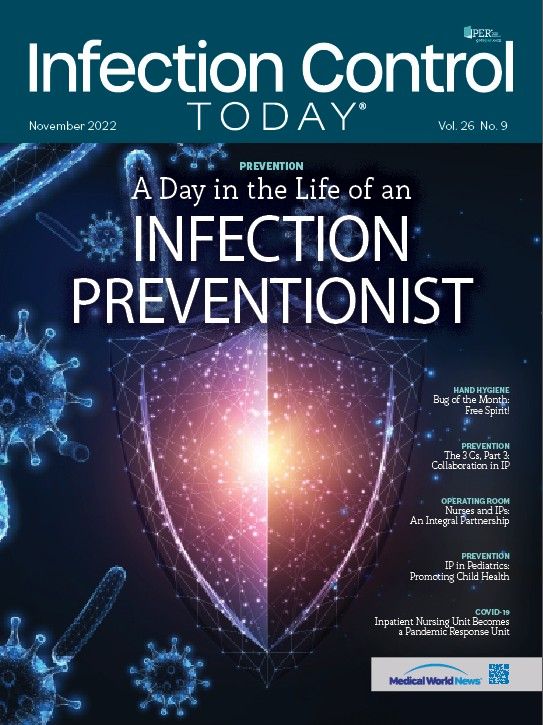Infection Control in Pediatrics: Primary Preventions to Promote Child Health
Infection prevention in pediatrics is crucial to keep babies and children healthy. Some of the main tools are hand washing and vaccinations; however, there is more to do.
Infection prevention in pediatrics (Adobe Stock)

Although many news outlets are quick to use the term “post pandemic” for a public eager to hear it, the truth is that COVID-19 is here to stay. In the early days of the coronavirus outbreak, a national narrative that children were not adversely affected quickly became mainstream communication. The physical burden of disease was not significant at first, but the toll on mental health, including emotional, social, and psychological well-being, was severe. Children also experienced greater adverse health outcomes, with the emergence of the Delta strain, with rising concern over conditions such as myocarditis and pediatric inflammatory multisystem syndrome.1
Disruption of Pediatric Care Delivery Systems
COVID-19 set in motion a chain of events that catastrophically disrupted the pediatric health care delivery system.2 Alongside mandated social distancing and implementation of other infection control measures, seasonal influenza and respiratory syncytial virus (RSV) patterns were severely disrupted, prompting off-season outbreaks. Vaccination rates plummeted across the board, creating vulnerabilities to communicable disease outbreak not seen in nearly a century.3 Providers, particularly in telehealth, were more inclined to prescribe antibiotics “just in case” in the face of a lack of treatment guidelines and parameters for COVID-19 and escalating parental fears, increasing the risk for antibiotic resistance.4 Pediatric nurses, seen as expendable cost burdens in the first phase of the pandemic, were laid off, creating a shortage of experienced health care providers equipped to serve families with education and interventions to promote infection prevention.5 Parents grew frustrated with social restrictions, fearing the unknown resulting harms. Many protested or even refused to adhere to public health guidelines.4
Increasing Risk for Transmissible Communicable Disease
Recently, the Centers for Disease Control and Prevention (CDC) significantly revised the restrictions associated with COVID-19 infection.6 This means more children than ever in the last 3 years are back in school, attending extracurricular activities, traveling, and visiting friends and family. The seasonal virus patterns on which we rely to predict the probability of a severe influenza or RSV season point to what is likely to be a winter with significant respiratory disease burden.7
Effective Primary Prevention of Pediatric Infections
The public narrative and family concerns seem to fixate on debates over vaccination for COVID-19 and influenza; but it is critical for pediatric health care providers to maximize every opportunity to educate parents and encourage them to implement a layered protection approach. Basic infection prevention measures are time tested, evidence based, and essential in providing robust protection against the transmission of communicable disease.
Handwashing
Since the days of Florence Nightingale, great emphasis has been placed on the importance of cleanliness, hydration, nutrition, sunlight, and environmental hygiene as critical factors in infection prevention.8 It is well documented that effective handwashing is by far the best way to prevent organism transmission. These days, in which heated debates often rest on technical aspects of infection control such as immunoassay and mRNA vaccination technology, it is crucial to emphasize to parents that modeling a primary barrier of protection such as handwashing cannot be underestimated. The CDC estimates that approximately 1.8 million child deaths occur each year from communicable disease, but advises that effective handwashing could protect as many as 1 in 3 children from diarrheal illnesses and 1 in 5 children from respiratory illnesses.9
Families should wash their hands before, during, and after food preparation; before eating; when arriving back home after being in the community; after toileting; after caring for or playing with pets; and after playing outside. Children should be taught to cough into their elbow or a tissue and to wash their hands afterward. There is no scientific evidence to demonstrate that antibacterial soap is more effective than regular soap, and emphasis should be placed on timing and method. Evidence shows handwashing is most effective when done for 20 seconds with water (warm or cold) and soap, which work together to trap germs and remove them. Hand sanitizer should be used only when handwashing is not possible or after handwashing is completed and should contain at least 60% alcohol. For health care providers, hand sanitizer is recommended as primary sanitation because of the extreme frequency with which hand hygiene is needed. Evidence is inconclusive whether drying with a paper towel or a hand dryer is more sanitary, but regardless, germs spread more easily with wet hands and should be dried quickly.9
Nutrition and Sleep
Increased risks of severe COVID-19 complications in the presence of preexisting health conditions invigorated dialogue about the importance of basic hygiene measures, optimal nutrition practices, and sleep hygiene in the role of infection prevention. These general measures of health are evidence based regarding the prevention of infection complications. The role of sleep is important in immune regulation response. Children should get an adequate amount of sleep each night with a consistent bedtime routine.2 Every effort should be made to provide nutritious meals. These are significant considerations for underserved populations who may have less reliable access to steady childcare while working essential jobs or limited financial means to access nutritious foods. Pediatric care providers should screen all families for food insecurity and make every effort to connect patients to resources while respecting and preserving their dignity.10
Antibiotic Stewardship
Each year in the United States, there are 2.8 million antibiotic-resistant infections with more than 35,000 deaths. The annual cost to treat multidrug-resistant infections is more than $4.6 billion.11 Antibiotic stewardship is vital in preventing the development of drug-resistant infections in children. An estimated 29% of antibiotic prescriptions for nonhospitalized children are improperly prescribed. Diagnoses of otitis media, pharyngitis, and sinusitis often result in improper antibiotic selection, and nonsuppurative otitis media, bronchiolitis, influenza, and viral upper respiratory infections often result in unnecessary antibiotic prescribing. Adverse reactions including Clostridioides difficile infection, gastrointestinal upset, and allergy or anaphylaxis can occur.12
The CDC provides free training on antibiotic stewardship including topics such as opportunities for improvement in antibiotic prescribing, communication training for clinicians, and risks and benefits of antibiotic therapy. Providers should self-evaluate antibiotic prescribing practices and implement or participate in an antibiotic-prescribing tracking and reporting system. In addition, care should be taken to educate patients about the potential harms of antibiotic treatment.13
Vaccination
Vaccines are a miracle of modern medicine but are now a widely contentious topic as parental hesitancy and refusal increase. The World Health Organization reports an estimated 25 million infants missed scheduled vaccine doses in 2021, 2 million more than in 2020 and 6 million more than in 2021.14 Providers should use every visit as an opportunity to ensure that every child has maximum protection from vaccine-preventable illness, rather than simply assessing that during well-child visits. Communication about parental concerns should be collaborative, not combative, conveying empathy and respect. Addressing specific parental questions and concerns should take priority over generalized assumptions or a templated approach to vaccine education.15 Recall systems are well established in their effectiveness to increase vaccination rates, regardless of delivery methodology.16 In the face of increasing parental requests for alternative vaccine schedules, providers should follow the guidelines on routine immunization as published by the CDC and the Advisory Committee on Immunization Practices. This includes all routine childhood vaccinations, seasonal influenza vaccination, COVID-19 vaccination, and catch-up vaccinations.17
Conclusion
Partnership between families and pediatric providers is essential to support a multilayered approach to providing a comprehensive infection control strategy. As the world moves into a new phase of living with COVID-19 and analyzes lessons learned, collaborative relationships cultivated with empathy and understanding will create an effective scaffolding to help children attain optimal health.
References:
- Peck JL. COVID-19: impacts and implications for pediatric practice. J Pediatr Health Care. 2020;34(6):619-629. doi:10.1016/j.pedhc.2020.07.004
- Bartek N, Peck JL, Garzon D, VanCleve S. Addressing the clinical impact of COVID-19 on pediatric mental health. J Pediatr Health Care. 2021;35(4):377-386. doi:10.1016/j.pedhc.2021.03.006
- Seyed Alinaghi S, Karimi A, Mojdeganlou H, et al. Impact of COVID-19 pandemic on routine vaccination coverage of children and adolescents: a systematic review. Health Sci Rep. 2022;5(2):e00516. doi:10.1002/hsr2.516
- Payvandi L, Correa ET, Hatoun J, O’Donnell H, Vernacchio L. Trends in telehealth antibiotic prescribing for children through the COVID-19 pandemic. Pediatrics. 2022;150(3):e2022056209. doi:10.1542/peds.2022-056209
- Peck JL, Sonney J. Exhausted and burned out: COVID-19 emerging impacts threaten the health of the pediatric advanced practice registered nursing workforce. J Pediatr Health Care. 2021;35(4):414-424. doi:10.1016.j.pedhc.2021.04.012
- Massetti GM, Jackson BR, Brooks JT, et al. Summary of guidance for minimizing the impact of COVID-19 on individual persons, communities, and health care systems – United States, August 2022. MMWR Morb Mortal Wkly Rep. 2022;71(33):1057-1064. doi:10.15585/mmwr.mm7133e1
- FluSight: flu forecasting. CDC. Updated April 13, 2022. Accessed September 17, 2022. https://www.cdc.gov/flu/weekly/flusight/index.html
- Statistics & evidence-based healthcare: hospital-acquired infections. Florence Nightingale Museum. Accessed September 17, 2022. https://www.florence-nightingale.co.uk/hospital-acquired-infections/
- Handwashing in communities: clean hands save lives. CDC. Updated March 21, 2022. Accessed September 17, 2022. https://www.cdc.gov/handwashing/index.html
- Food insecurity. American Academy of Pediatrics. Accessed September 20, 2022. https://www.aap.org/en/patient-care/food-insecurity/
- National infection & death estimates for antimicrobial resistance. CDC. Updated December 13, 2021. Accessed September 17, 2022. https://www.cdc.gov/drugresistance/national-estimates.html
- Butler AM, Brown DS, Durkin MJ, et al. Association of inappropriate outpatient pediatric antibiotic prescriptions with adverse drug events and health care expenditures. JAMA Netw Open. 2022;5(5):e2214153. doi:10.1001/jamanetworkopen.2022.14153
- CDC TRAIN: CDC’s antibiotic stewardship training series. TRAIN. Accessed September 21, 2022. https://www.train.org/cdctrain/training_plan/3697
- COVID-19 pandemic fuels largest continued backslide in vaccinations in three decades. News release. World Health Organization. July 15, 2022. Accessed September 1, 2022.https://www.who.int/news/item/15-07-2022-covid-19-pandemic-fuels-largest-continued-backslide-in-vaccinations-in-three-decades
- Shared decision making. American Academy of Pediatrics. Updated December 7, 2021. Accessed September 13, 2022. https://www.aap.org/en/practice-management/providing-patient--and-family-centered-care/shared-decision-making/
- Edwards KM, Hackell JM; Committee on Infectious Diseases, The Committee on Practice and Ambulatory Medicine. Countering vaccine hesitancy. Pediatrics. 2016;138(3):e20162146. doi:10.1542/peds.2016-2146
- Catch-up immunization schedule for children and adolescents who start late or who are more than 1 month behind. CDC. Updated February 17, 2022. Accessed September 13, 2022. https://www.cdc.gov/vaccines/schedules/hcp/imz/catchup.html
